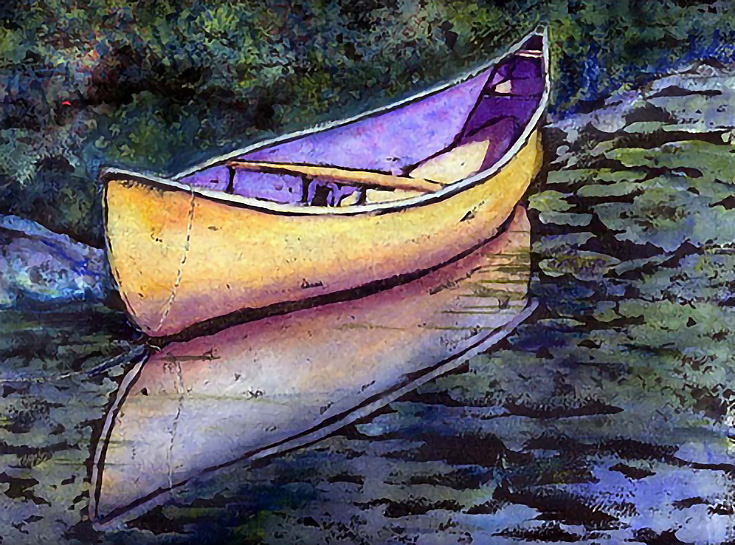Today I want to share a fun painting technique that works well with watercolors and—actually—almost any other media!
You’ll need some gouache or tempera paint (which is water soluble) plus India ink (which is waterproof). Combine those mediums with watercolors, and you can easily create a splendid finished work of art like the one below.

NOTE: You will not want to use your good brushes for either the ink or the tempera paint or your brushes will be ruined. Cheaper brushes should work just fine, or use some older brushes that you don’t care about.
Let’s get started!
1. Prepare your painting surface
Begin by taping or stapling down a good-quality watercolor paper on your board. (I use 140lb Arches hot or cold pressed paper since it stands up well to the scrubbing needed to rub off the India ink.) Then sketch your composition with pencil.
2. Choose the areas to protect from ink
Once you have your sketch done, decide which areas in the painting you want to protect from the India ink. These are the areas you’ll eventually paint with watercolors, so you’ll be adding tempera to them in the next step. (The tempera will act as a resist and protect those sections from the ink that you’ll brush on later.)
3. Add tempera or gouache
Pour out a bit of tempera into a lid or small container and start to paint with tempera. Leave any areas untouched that you’d like the ink to settle into. Do not wet your brush with water as this will dilute the tempera and you will end up with the tempera not covering the areas properly.
If you must clean your brush off due to it getting too thick with paint, make certain you squeeze out all excess water from the brush before dipping it back in the tempera.
Keep in mind, if you apply a thin layer of tempera, some of the ink that you’ll brush on in the next step will seep through and slightly darken that area. If you use a thick layer of tempera, the paper underneath will remain whiter because less ink will seep through.
After you’ve finished adding the tempera, check your drawing to make sure you have covered everything you’ll want to paint with watercolors later. If you leave your pencil lines uncovered (as I usually do) your ink wash will create thick black lines in their place—which makes for nice contrast in your finished paintings. However, ANY areas that have not been painted with tempera will become black once the ink is applied, not just your lines, so it never hurts to double-check.
If you’re sure you’re finished, allow the tempera paint to dry or help it along with a hair dryer. It must be completely dry before the next step.
4. Apply India ink over the entire surface
Make sure you have either a 1 inch or 2 inch flat bristle brush or sponge brush, depending on the size of your paper—you will want to cover the entire sheet with ink quickly and with as few strokes as possible. (The goal is to NOT disturb the tempera paint underneath, so fewer strokes is better.)
Pour a bit of India ink in a small container, then fill your brush with the ink (and I mean fill it, not just the tip of it – put your entire brush in it!) Begin at the top of paper and brush light, quick sweeps back and forth, overlapping each stroke just a bit. Refill the brush with ink often, otherwise you may get streaks.
NOTE: Use rubber gloves for this step, and don’t wear your good clothing – the ink gets everywhere!
Should you get streaks, quickly touch them up carefully. Continue until the painting is completely covered and then set aside to dry fully. Grab your hair dryer if you want to speed things up. Make sure it is completely dry by doing touch test with the back of your hand. If it feels cool it is still wet.
5. Remove the tempera (and some ink)
Once the ink is bone dry, bring your painting to the sink and gently, run some warm tap water (not hot) over the painting in the sink. Tilt the board and lightly rub the ink from your painting. Lift your paper from sink every now and then to allow dirty water to run off the paper. The tempera and ink will dissolve leaving the ink outlines intact.
Have one last look and make sure any excess water has dripped off, then gently lift your painting out of sink and lay it on towel. Use a separate towel to blot carefully. Try to avoid streaking the ink, but keep in mind that in some cases it’s unavoidable based on how each of the previous steps went.
Allow another waiting period for the paper to dry (on a flat surface!) and again use a dryer if you want to speed things up.
6. Add color
Once your painting has dried completely, you can leave it black and white for a high-contrast graphic, or use watercolors to add color to the sections kept clean with the tempera.
If watercolors aren’t your thing, you can also use pastels, acrylics, water-soluble crayons (like the piece above) or almost any other medium.
Have fun!
For more from Alice Sawicki, please visit her website at www.artistmom.net.
This post may contain affiliate links.

